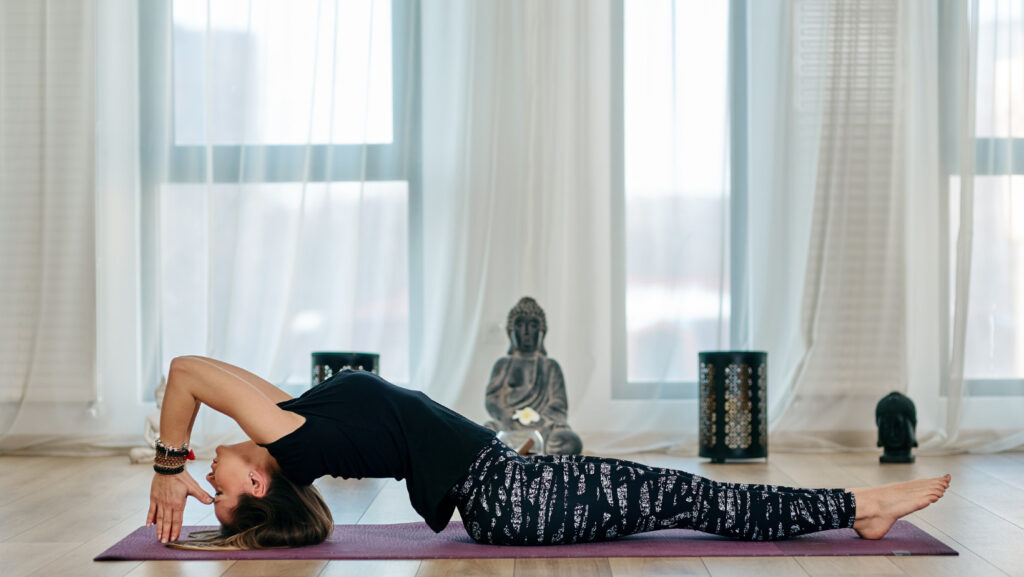
There are several important pieces to consider when a yoga teacher begins sequencing a yoga class. Many schools of yoga define vinyasa as a method of yoga in which movements form a flowing sequence in coordination with the breath. This school of thought aligns with Patanjali’s eight limbs of yoga. According to Patanjali, sana is the third limb of yoga and, in essence, it is a moving meditation. The eight-limbed path tells us that all limbs of yoga should be incorporated into daily practice if we want an authentic, holistic yoga experience.
Michelle Young states in My Vinyasa’s practice online teacher training, “The intent of asana is to provide a safe physical space for students to explore their physical containers. I’ve found that instructing students to bring their awareness to the relationship between breath and body…can bring each student back to the present moment.” With this intent in mind, yoga instructors and yoga teachers can begin to sequence yoga classes to support their students. They can also teach their students to sequence classes in this way for their personal practice. This intent is the same if designing a 30 minute yoga class, a beginner yoga vinyasa flow or a class with advanced yoga poses in the sequence. Yoga sequencing can go beyond asana and include historical references, yoga philosophy, tantra practices, and pranayama techniques.
A sequence is the order and structure of a yoga class that’s meant to provide students with a safe flow of movements that are linked to and regulated by the breath. Below is an example of one in which we can describe the structure of a yoga sequence.
The arc of a yoga class:
- Setting up the breath/Grounding
- Warm-up
- Flow to Peak
- Inversions/backbends
- Abdominal Work
- Cool down
- Savasana
In a traditional vinyasa sequence, the yoga instructor works with the students as a group to set up the breath. Michelle Young states, “This simple act helps students energetically balance together through co-regulation. You can help students to establish the breath in a number of ways. For example, you can call the class to order with several rounds of breath in a seated position. Another example is to begin movement with gentle asanas while instructing students to guide their bodies through the asanas with their breath.” It is also common for the yoga instructor to guide students through a Sun Salutation to warm the body. Sun Salutation A contains the sequence of postures known as a vinyasa that includes chaturanga. This is an appropriate time to teach the standard asanas in this sequence and to introduce options accessible for all levels.
After the warmup, the class will continue to move through asanas that support preparing the body for the peak pose. This is called the flow to peak phase. During this phase, the teacher will guide students through the asanas with a focus on communicating the theme and purpose of the class. For example, if the peak pose of the class is Camel pose and the goal is to prepare and lead students to this pose, a series of preparatory less intense backbends would be offered first. Puppy pose and cobra pose would be helpful to prepare the spine for deeper extension. The flow-to-peak section is meant to guide students to toward building awareness of their bodies in reference to the safely aligned anatomical actions needed for the peak pose. Once you’ve taught to the peak of the class, it is time to guide students through finishing postures that may include abdominal strengthening and inversions.
The cool down portion of the class can include gentle poses that counterbalance the asanas that were done in the flow to peak phase. Our anterior bodies are counterbalanced by our posterior bodies. For example, in our sequence with camel as a peak pose, forward folds would be complementary such as a bound angle forward fold or Paschimottanasana, emphasizing the flexion of the spine.
After the cool down, the class ends with Savasana which should consist of 10 to 20 percent of the time of the total class. This will allow for full integration of the practice, regulation of the heart rate and nervous system, and promotes deep relaxation of the body and mind.
